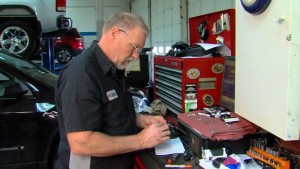
A new AAA study shows that a third of American drivers would have to go into debt in order to make a significant repair on their vehicle.
It’s the rare driver who hasn’t run into an unexpected problem, whether a blow-out or a blown engine. And while most Americans can find a way to squeeze the necessary money out of the household budget, a new AAA study warns that a full third of U.S. drivers would not be able to handle a sudden vehicle repair without going into debt.
The average repair bill is now running between $500 and $600, according to the report. But the figure can vary widely, with major engine and transmission problems pushing up into the thousands. Even without unexpected repairs, AAA noted, the average cost of owning and operating a vehicle is now up to around $8,500 annually.
“Millions of Americans are failing to set aside a car care fund to pay for the upkeep of their cars,” said John Nielsen, AAA’s managing director of Automotive Engineering and Repair. “To avoid a surprise down the road, drivers should budget for monthly payments, insurance premiums, fuel costs and the inevitable expenses of routine maintenance and repair.”
Some repairs just can’t be avoided. Ask anyone driving in Snowbelt states like Michigan who has blown a tire or bent a rim on a deep pothole. But many problems can be prevented, stressed Nielsen, with routine maintenance. That includes regular oil changes and tune-ups. The owner’s manual is the best place to check to see when such work should be scheduled.
(Analysts predicted March sales would rise 2% over 2016 results. Click Here to see why.)
“Anticipating your vehicle’s needs before problems strike is important,” Nielsen said. “While it may seem that skipping maintenance and repairs can save money in the short term, staying on top of car care can save drivers hundreds of dollars in the long run.”
And it can help prevent unexpected, roadside emergencies. AAA said it handled 32 million stranded motorists last year alone.
The reality is that some problems can’t be prevented – that pothole-induced blowout, for example. And major, unexpected repairs are routinely the problem of those least able to afford them – owners of older used vehicles. Those are almost always out of warranty, which means a driver will have to come up with cash to make the repair.
(Click Here for details about car buyers getting longer loans.)
AAA says motorists who run into repair problems should take several steps:
- Ask for a written estimate that clearly shows what work will be needed, and make sure the shop contacts you if the mechanic discovers additional problems that need repair;
- Consider going to another shop for a second opinion, much as you would for surgery or another medical procedure;
- Try to negotiate with the mechanic or service advisor and ask whether the shop offers discounts. Many chains, in particular, will offer deals if you belong to AAA or other roadside service clubs or organizations such as AARP.
(Leasing levels surge, raise concern. Click Here to see why.)
Nielsen also recommends that motorists consider routinely setting aside a small fund to have on hand in the event of a major, unexpected repair. That’s especially sound advice for those with older vehicles that can’t count on a warranty for protection.

Here’s something else. The last car I bought I got all the safety features on it. Cost me an extra $3000.00 for them but figured it was worth it if it keeps me from having an accident. Also figured it would lower my insurance rate, wrong, they charged me more for having them. They said that if I get into a wreck that it will cost more to repair if these safety features are damaged. Wow, they got you going and coming.